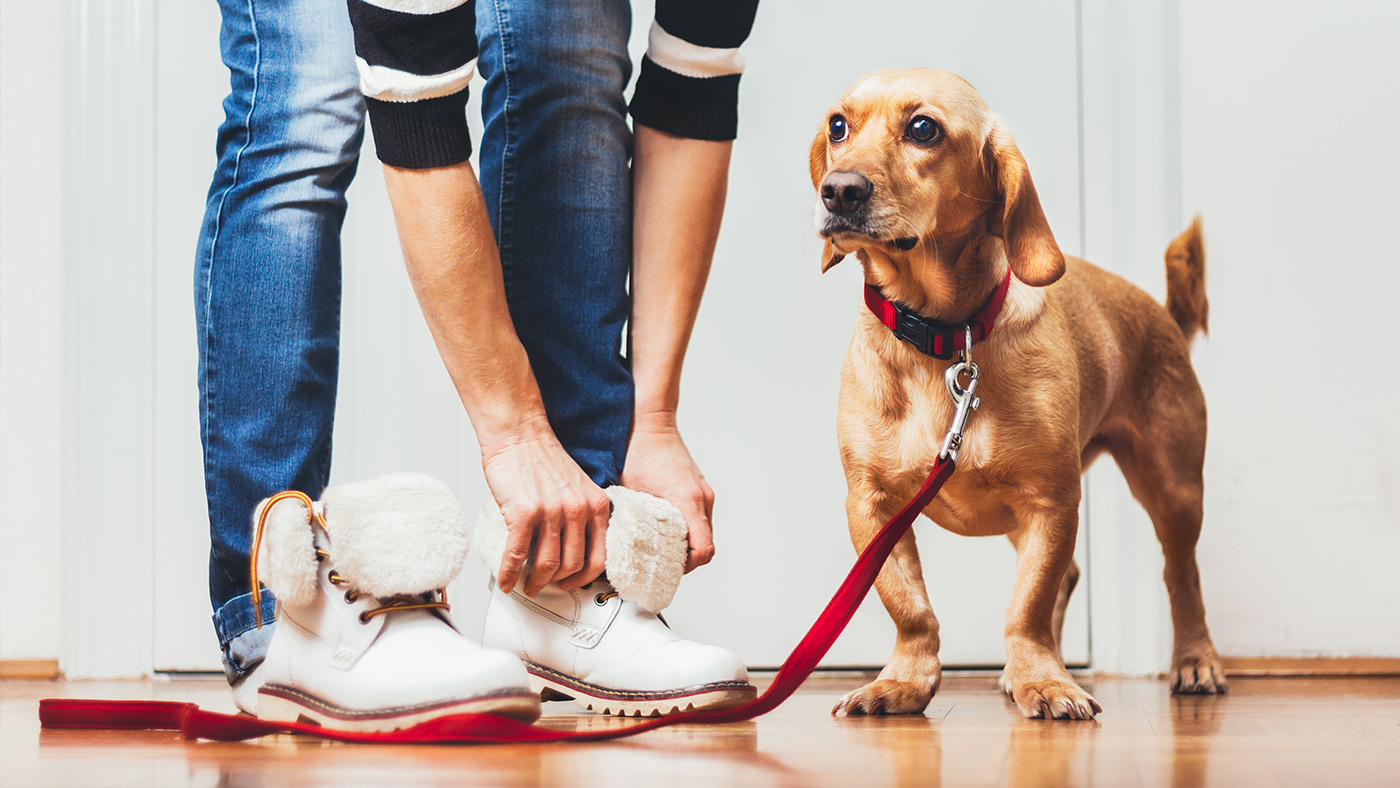Do calming treats for dogs work? A vet's opinion
An expert vet weighs in on the benefits of calming treats for dogs.

Stress and anxiety are often the cause of unwanted behavior in our furry friends, but do calming dog treats actually work?
Calming dog treats are designed to help your pooch calm down, letting them focus on their delicious snack, and distracting them from whatever is upsetting or unsettling them. The good news is that yes, they do really work. Much like the best long-lasting dog chews, calming dog treats are designed to last for a while, giving your canine something to focus on. This helps keep their thoughts away from whatever it is that is upsetting them for longer than you’d manage with just the best dog treats.
There are a lot of potential causes of stress in dogs, including separation anxiety, fear of loud noises, or even meeting new people. If you find your pooch starts whining, barking, or even howling when exposed to any of these conditions, then a calming dog treat could help.
It’s important to note that the best calming dog treats aren’t miracle workers — they will work for some dogs and some causes of stress. They work best when combined with other de-stressing tools, like the best calming dog beds, and they’re best saved for minor cases of stress and anxiety. If your dog has serious stress issues, as always we’d recommend talking to your vet.
We’ve put together this guide to answer all your burning questions about calming dog treats, including what types there are, how long they last, and what to do if they aren’t working. We also consulted with expert vet Dr. Elizabeth Racine to make this the most comprehensive guide to calming dog treats on the web.

Dr. Elizabeth Racine is a doctor in veterinary medicine, after graduating from Atlantic Veterinary College (AVC) in 2017. Whilst there, Dr Racine was the Co-Founder and Co-President of the AVC Nutrition Club and was also actively involved in many other clubs at AVC, including: Pathology Club. Bovine Club, Teaching Animal Enrichment Club, Small Ruminant Club, and Internal Medicine Club. She now covers all things related to pet health and wellness.
When to use calming dog treats

Calming treats are best suited for dogs that have mild anxiety. They can help take the edge off some minor nervousness, but they won’t magically cure your dog’s separation anxiety or leash reactivity.
If your dog has relatively mild anxiety symptoms, such as lip-licking or occasional pacing, then calming treats may be enough to help take the edge off his anxiety and allow him to relax.
However, severe anxiety symptoms such as restlessness, trembling, panting, or aggressive behavior are unlikely to resolve with calming treats. It’s also important to remember that calming treats alone won’t solve the underlying issue – as with any anxiety problem, a combination of both medication and training is needed to address the fear that triggers your dog’s anxiety behaviors.
Types of calming treats for dogs
Some calming treats can be given on an as needed basis – such as just before a thunderstorm, fireworks, or a stressful car ride. Other types of calming treats need to be given daily over a longer period of time because the active ingredients need to build up in your dog’s body in order to work effectively.
Calming supplements are also available, which are added to your dog’s food or given like a pill on a daily basis to help alleviate your dog’s anxiety. Your veterinarian can help you choose which type of calming treat or supplement is right for your dog based on your dog’s triggers and the severity of your dog’s anxiety.
The ingredients in calming treats vary widely depending on the product. Some calming products use herbal remedies to reduce stress and anxiety. Others rely on naturally occurring proteins such as casein and whey protein, which are derived from milk, and tryptophan, which is the amino acid that makes you feel sleepy after a big turkey dinner!
Many manufacturers are also starting to incorporate CBD oil into their products, although more research is needed to determine its efficacy in treating canine anxiety.
Are calming treats safe for dogs?
Over the counter calming treats are safe for most dogs. As always, it is important to consult your veterinarian first before starting any new medication or supplement to ensure that it will be safe and effective for your dog.
However, most dogs tolerate calming treats well and do not experience any adverse effects. Side effects from calming treats are uncommon. Depending on the type of treat, some dogs may experience a mild sedative effect and may seem drowsy or “out of it” after taking calming treats.
Other common and more concerning side effects that can occur from calming treats are vomiting and diarrhea. If these side effects occur in your dog, or if you have any other concerns about your dog’s health or behavior after starting calming treats, stop giving the treats and contact your veterinarian for further advice.
How often can I give my dog calming treats?

Calming treats are often dosed based on your dog’s weight, so you’ll need to check the manufacturer’s recommendations to find out how many treats to give your dog. You can usually find these instructions on the back of the treat bag or container. The frequency of dosing for calming treats depends on the type of treat you choose.
Some calming treats are dosed daily or even multiple times a day, while others are only given on an as needed basis. For dogs with generalized anxiety or separation anxiety, a daily chew is likely best, while dogs with episodic phobias – such as a fear of thunderstorms – likely only need calming treats right before a storm or other stressful event.
Be sure to read the instructions on the bag of treats to determine how often your dog should be consuming the treat, or consult your veterinarian for dosing instructions.
Do calming treats for dogs work?

Calming treats for dogs can work well to alleviate mild stress and anxiety for some dogs. There are many different types of calming treats available on the market. What works well for one dog may not work as well for another, so you may experience some trial and error before finding the product that works best for your dog.
Choose a product that is geared towards your dog’s situation: for example, if your dog is frightened of thunderstorms, a calming treat designed to be given on an as-needed basis, just before a storm begins, will likely be best.
If your dog has anxiety daily, a product that is designed to be given on a daily basis will likely be a better fit. Before starting any new supplement, make sure to ask your veterinarian for recommendations – he or she may have a product in mind that will work best for your dog’s individual needs.
What to do if calming treats don't work?

If calming treats aren’t working well for your dog, it is likely because his anxiety is too severe for this very mild form of treatment. In these cases, a more in-depth treatment plan is necessary to address the behavior.
First, a visit to your veterinarian is in order. Your veterinarian will take a thorough history, including a detailed account of when the problem started, what triggers the anxious behavior, and what happens before, during, and after an anxious event.
If possible, try to record your dog’s behavior at home so your veterinarian can get a detailed look at what is going on – this can be a huge help in identifying potential triggers for the behavior. Your veterinarian can then help you find ways to avoid or manage these triggers so that your dog will not be so stressed in the future.
Next, your veterinarian will perform a full physical examination on your dog and he or she may also recommend some additional diagnostic testing. This is an important step to identify any areas of pain or illness. Just like us, dogs can be more irritable, restless, stressed, anxious, or even aggressive if they’re not feeling well. Identifying and treating any underlying medical problems may help alleviate some of your dogs behavioral issues.
Finally, your veterinarian will discuss a behavior modification plan with you. Depending on the severity of your dog’s issues, this may include an at-home training plan, calming supplements, prescription medications, referral to a positive reinforcement-based dog trainer, or a consult with a board certified veterinary behaviorist.
In some cases, you may be advised to pursue all of the above! It is very important to follow your veterinarian’s recommendations closely and follow up frequently so that your dog’s treatment plan can be adjusted as needed. Your dog’s success depends on the teamwork between you, your trainer, your veterinary team, and of course your pup!
Calming treats: Just one tool for canine anxiety
Many pet owners mistakenly believe that if calming treats don’t work, they’ve run out of options for treating their dog’s anxiety. This is not true! Calming treats are just one tool for addressing canine anxiety and a very mild one at that.
There are many other resources available to help your dog. Talk to your veterinarian to learn more about your options for prescription medications and positive reinforcement-based dog training, both of which can help address and manage your dog’s anxiety.
Wondering how to discipline a puppy? We’ve got some tips.
EcoKind Pet Treats Premium Yak Chew
$23.95 from Amazon
These long-lasting dog chews are made with 100% Yak milk, offering a healthy, tasty, and safe snack for your pooch to gnaw on when they're feeling anxious.
PetsRadar Newsletter
Get the best advice, tips and top tech for your beloved Pets
Dr. Elizabeth Racine is a small animal general practice vet covering all things pet health and wellness. Her special interests include veterinary behavior, nutrition, and internal medicine.
As a freelance writer, Dr. Racine has written content for major companies in the industry such as the American Kennel Club, Merck Animal Health, Bayer PetBasics, Elanco, and CareCredit. In her free time, Dr. Racine enjoys playing trampoline dodgeball, hiking with her beagle Dasher, and spending time with her three mischievous cats.

